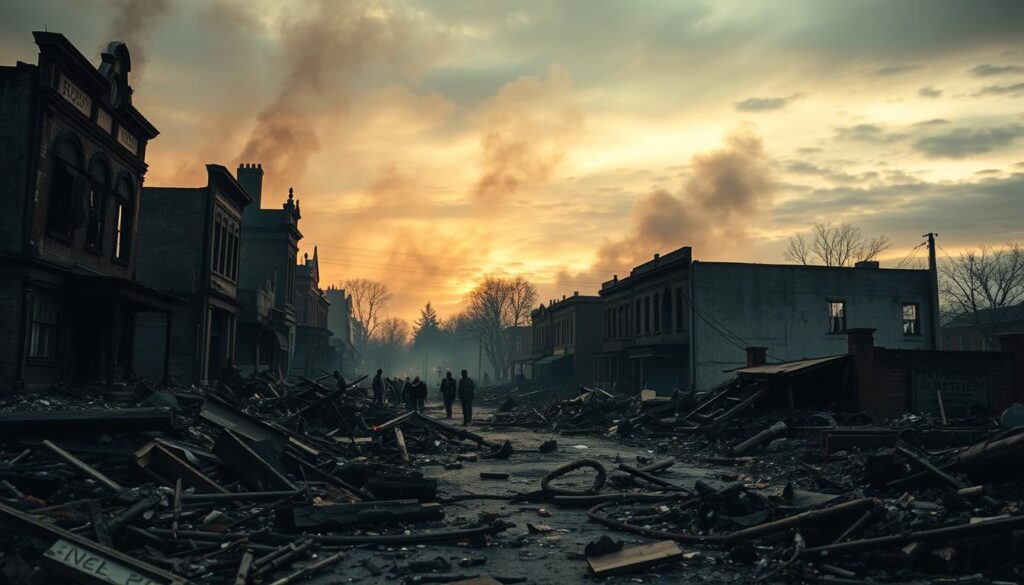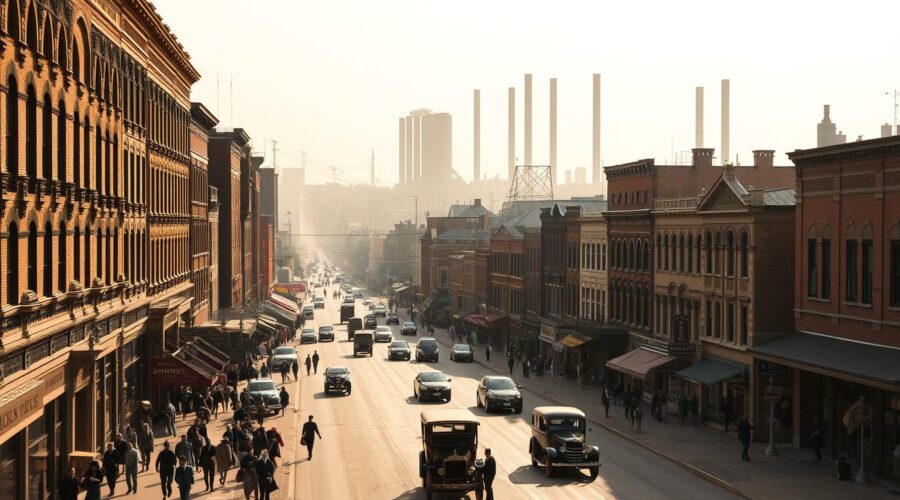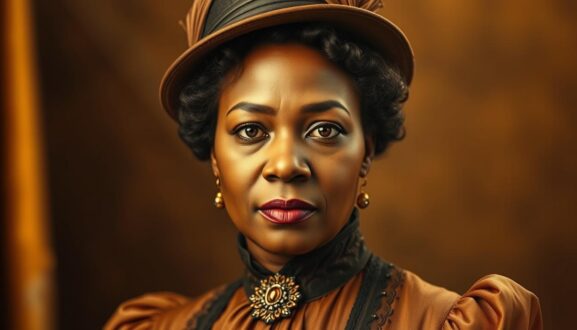Exploring the Rise and Fall of Black Wall Street
Black Wall Street was a shining example of Black entrepreneurship in Tulsa, Oklahoma’s Greenwood District. It thrived in the early 1900s, becoming a symbol of success. The district was filled with businesses, schools, and cultural spots, showing the community’s strength against racism.
By 1921, Black Wall Street had become a thriving economic hub. But, racial violence during the Tulsa Race Massacre ended its success. This story shows the power of Black communities and the harsh effects of inequality.
Today, the legacy of Greenwood District is a key part of American history. Understanding Black Wall Street’s journey teaches us about community strength and its loss.
Key Takeaways
- Black Wall Street in Tulsa Oklahoma represented a unique African American business district.
- Greenwood District’s success defied racial barriers in early 20th-century America.
- Its destruction in 1921 marked a turning point in Black entrepreneurship history.
- The community’s innovations inspired future generations of Black business leaders.
- Efforts to preserve its story help honor both its triumphs and tragedies.
The Birth of a Thriving African American Community
In the early 1900s, the Greenwood District history started with bold steps. It was a time of Black self-reliance. Thanks to federal policies and leaders like O.W. Gurley and J.B. Stradford, Oklahoma became a haven for African Americans.
Origins in the Greenwood District of Tulsa
Greenwood began in 1906 when O.W. Gurley bought 40 acres north of Tulsa. This move was part of Oklahoma’s unique history. It allowed formerly enslaved people to own land through the Dawes Act. This Black land ownership helped create a community safe from Jim Crow laws.
Early Founders and Visionaries
| Name | Role | Impact |
|---|---|---|
| O.W. Gurley | Land Developer | Purchased 40 acres, establishing Greenwood’s first streets and businesses |
| J.B. Stradford | Entrepreneur & Lawyer | Opened the 60-room Dreamland Theater and promoted Tulsa as a safe haven for Black migrants |
Economic Foundations in Post-Civil War America
- Land Allotments: Oklahoma’s policies allowed Black settlers to claim 160 acres. This helped create Oklahoma Black towns like Boley and Taft.
- Entrepreneurial Spirit: By 1921, Greenwood had over 600 Black-owned businesses. This included banks, grocery stores, and the Stradford Hotel.
- Oil Boom Benefits: Tulsa’s oil wealth helped Greenwood. It funded schools, newspapers, and insurance companies.
Historical Context: America in the Early 20th Century
In the early 1900s, the Jim Crow era enforced racial segregation across the U.S. South. Laws barred Black Americans from schools, jobs, and voting. This pushed many to build their own communities. Tulsa’s Greenwood District grew as a response to this oppression, offering hope amid systemic barriers.
Between 1916 and 1930, the Great Migration brought over 6 million African Americans north and west. Many settled in cities like Tulsa, seeking factory jobs and escape from Southern violence. These moves reshaped urban demographics, creating new opportunities—and new challenges.
Post-WWI America brought mixed changes. Industrial growth and war-driven demand created jobs, but Black workers faced exclusion from many fields. Soldiers returning from the war often found their service unrecognized by white-dominated institutions. Cities like Tulsa became hubs of resilience, where Black entrepreneurs turned obstacles into chances for Black economic development.
Despite laws and prejudice, Tulsa’s Greenwood District became a beacon. Its success showed what could happen when Black Americans pooled resources, defying odds stacked against them. This era’s struggles set the stage for a community that refused to be limited by hate.
The Economic Marvel of Black Wall Street
The Greenwood District was a shining example of Black-owned businesses at its peak. It showed the Greenwood prosperity that broke through barriers. With over 600 businesses, from pharmacies to hotels, it created jobs and wealth.
These businesses were more than just profitable. They were the heart of the community, building pride and self-reliance.
Businesses and Enterprises That Flourished
Places like J.B. Stradford’s hotel and the Dreamland Theatre were the lifeblood of the district. A mix of retail, services, and entertainment made Greenwood self-sufficient. Innovation and community needs drove success.
| Business Type | Example | Impact |
|---|---|---|
| Retail | G.W. Williams Grocery | Employed locals, met daily needs |
| Cultural | Dreamland Theatre | Showed films and hosted jazz legends |
| Professional | Law offices of A.C. Jackson, MD | Provided healthcare and legal services |
Banking and Financial Institutions
Black financial institutions like the Greenwood Improvement Association’s loan programs empowered entrepreneurs. These banks offered mortgages and business loans to Black residents. They fueled home and business ownership.
Their loans helped build schools and shops that became community pillars.
Education and Professional Services
Professionals like dentist Dr. A.C. Jackson and lawyer M.C. Gibson were leaders in Black professional services. Their practices and schools like the Greenwood School District ensured access to education and healthcare. They didn’t just work—they led movements for racial uplift.
Daily Life and Community in Greenwood
Life in Greenwood District was more than just money—it was full of traditions, laughter, and shared goals. The Greenwood community life was vibrant, fueled by care and cultural pride. Families and friends were the heart of this lively place, where neighbors supported each other always.
Family Structures and Community Support
African American family life was strong because of networks beyond family ties. Mutual aid societies helped families in need, and local stores gave credit to neighbors. These Black social networks turned problems into chances for working together.
Religious Institutions and Their Role
Churches like Vernon AME and First Baptist were at the center of Black churches Tulsa. They offered Sunday services, literacy classes, and helped during the 1918 flu pandemic. These churches were more than places of worship—they were community pillars.
| Church | Key Contribution |
|---|---|
| Vernon AME | Ran a school and emergency aid programs |
| Mt. Zion Baptist | Hosted job training workshops and cultural festivals |
Entertainment and Leisure Activities
Nights were filled with music at the Dreamland Theater, where stars like Count Basie performed. Families enjoyed the Greenwood Rodeo or danced at the Stradford Hotel. Even picnics at Booker T. Washington Park were moments of joy, despite segregation.
- Weekly movie nights at the Williams Theatre
- Annual Juneteenth parades showcasing local talent
Growing Tensions in Tulsa
The success of Greenwood made white neighbors jealous. Tulsa racial tensions grew as white supremacy Oklahoma groups feared Black success. The pre-massacre environment became tense, fueled by economic jealousy towards Greenwood’s businesses and wealth.
The Tulsa Tribune made things worse with its biased headlines. A May 1921 article falsely accused a Black teenager of assaulting a white woman. This sparked outrage. Its coverage often portrayed Black success as a threat:
“Nab Negro for Attacking Girl in Elevator”
Racism and greed merged into a deadly mix. White supremacists saw Greenwood as a threat to their power. Ku Klux Klan recruitment soared in Oklahoma, targeting Black prosperity and defiance. False rumors from the Tulsa Tribune fueled panic.
This mix of jealousy and hatred was explosive. By 1921, the stage was set for a tragedy that would erase years of progress.
The Tulsa Race Massacre of 1921
On May 31, 1921, the Tulsa Race Massacre started. It was sparked by a false claim that Dick Rowland, a Black shoeshiner, had assaulted Sarah Page, a white elevator operator. This accusation, fueled by racist media, led to chaos. The next two days were a nightmare that destroyed the thriving Greenwood District.

The Triggering Incident
Rowland’s arrest on May 30 led to a clash between armed Black World War I veterans and white mobs. Newspapers falsely claimed a “Negro assault,” fueling the violence. By May 31, the Black Wall Street destruction started as rioters looted and burned homes, businesses, and churches. Private planes dropped firebombs, marking the first aerial bombing in U.S. history.
Timeline of the Violence
- May 31: Armed white mobs invaded Greenwood. Police deputized rioters instead of protecting residents.
- Firefighters were blocked from stopping flames as the Greenwood bombing intensified.
- June 1: Over 6,000 people were detained. Survivors described planes circling overhead, dropping explosives.
Scale of Destruction and Loss
- 35 city blocks reduced to ashes.
- At least 300 dead, buried in mass graves.
- Over 10,000 displaced, living in tents for months.
First-Hand Accounts and Testimonies
“I saw planes dropping lighted balls of wood,” recalled survivor Lessie Bates. “They burned everything.”
Survivors’ stories show the targeted destruction of Black wealth. Businesses like the Dreamland Theater and the Stradford Hotel—symbols of Greenwood’s success—were destroyed. The trauma of the massacre was hidden for decades, with its truth suppressed in official records.
Aftermath and Cover-Up
The Tulsa Massacre aftermath was tough for survivors like Viola Fletcher and Lessie Benning. Over 35 city blocks were destroyed, leaving 10,000 people without homes. Many were sent to internment camps, and insurance claims denied left them without compensation. Banks and businesses disappeared, but rebuilding was blocked by strict zoning laws.
Insurance companies like Prudential refused to pay out, leaving families broke. Courts threw out lawsuits, and newspapers like the Tulsa World called it “race riots.” This downplayed the role of white people in the violence.
Immediate Consequences for Survivors
Greenwood survivors lost everything: homes, businesses, and loved ones. Families were forced into tent cities. The insurance claims denied left them without financial support.
Official Response and Media Coverage
City officials made laws to stop Black-owned businesses from reopening. Newspapers like the Tulsa World first blamed Black “rioters” but later ignored the story. Despite over 800 injuries, no one was arrested.
The Erasure from Historical Records
- State education boards removed the event from Oklahoma textbooks until 2021.
- City archives suppressed survivor testimonies and property damage reports.
- Survivors like Hughes Van Ellis faced backlash for speaking openly about their trauma.
For decades, historical erasure kept the truth hidden. This silence made sure Greenwood’s fight and the nation’s role were forgotten. It wasn’t until recent investigations that the truth came to light.
Rediscovering Black Wall Street: Breaking the Silence
For decades, the Tulsa Race Massacre Commission kept the 1921 tragedy hidden. But in 1997, they revealed the truth. This historical rediscovery sparked efforts to save stories through oral history projects. These projects aim to keep alive the memories of those who survived.
“We had to tell our stories before it was too late,” shared one survivor’s recorded account.
Today, teams are digging up mass graves, finding physical evidence of the destruction. At the same time, demands for massacre reparations are growing. People want justice for the descendants of those affected.
| Initiative | Description | Impact |
|---|---|---|
| Oral History Projects | Interviews preserving survivor testimonies | Ensures voices are heard |
| Excavations | Archaeological digs locating massacre sites | Validates historical records |
| Reparations Campaigns | Efforts to address systemic harm | Promotes accountability and healing |

Now, documentaries, school lessons, and memorials share this important history. Every find, from oral history projects to Black Wall Street excavation, keeps the memory alive. This work honors the past and works towards a fairer future.
Legacy and Impact on Modern Black Entrepreneurship
Today’s Black entrepreneurship looks up to the Greenwood legacy. Greenwood’s success was built on wealth for all and putting community first. Now, places like Atlanta’s Auburn Avenue and Durham’s Hayti Heritage District are following this path. They show how Tulsa’s lessons can lead to economic empowerment today.
Lessons for Contemporary Business Communities
- Community reinvestment: Local dollars help Black-led networks grow stronger
- Cooperative networks: Greenwood’s businesses working together is a model for today
- Innovative financing: New ways to fund businesses replace old barriers
Memorial Efforts and Commemorations
The Black Wall Street memorials include the Greenwood Rising history center and Juneteenth tributes. The Tulsa Historical Society’s digital archives teach about resilience. As LaSheila M. Wilson says:
“These spaces aren’t just memorials—they’re launchpads for new Black-owned ventures.”
Educational Initiatives Preserving the History
Now, Tulsa Public Schools teach about Greenwood’s story. Scholarships from the Oklahoma Black Chamber help entrepreneurs learn from history. Universities like Howard and Spelman require courses on this legacy. This ensures future leaders know how to apply these economic strategies.
Conclusion: Remembering the Past While Building the Future
The story of Black Wall Street shows the Black community’s strength and resilience. It’s not just about remembering; it’s about taking action. The legacy of Greenwood teaches us about overcoming obstacles through unity and determination.
The Tulsa massacre highlights the need for racial economic justice today. It’s a reminder of the importance of addressing systemic inequalities. The values of Greenwood—entrepreneurship, education, and mutual aid—can help us today.
Efforts to honor Greenwood and support Black businesses keep its spirit alive. By learning from history, we can create communities where everyone can succeed. We must remember the past’s pain and use it to drive change. Black Wall Street’s story urges us to build a future where justice and equality are real.


